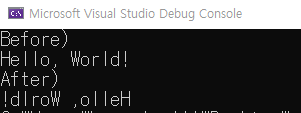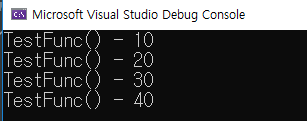1. 재귀 호출을 이용하여 값이 60 이하인 피보나치(Fibonacci) 수열을 출력하는 프로그램을 작성하세요. 참고로 피보나치 수열은 다음과 같이 앞 두 숫자의 합이 이어지는 모습을 하고 있습니다.
1 1 2 3 5 8 13 21 34 55
[소스코드]
#define _CRT_SECURE_NO_WARNINGS
#include <stdio.h>
void Fibonacci(int nLimit, int nBefore, int nAfter)
{
int nTmp = 0;
nTmp = nBefore + nAfter;
nBefore = nAfter;
nAfter = nTmp;
if (nBefore <= nLimit)
{
printf("%d ", nBefore);
Fibonacci(nLimit, nBefore, nAfter);
}
return;
}
void main(void)
{
Fibonacci(60, 0, 1);
return;
}[실행결과]

2. 인자로 char* 형을 받아서 문자열을 거꾸로 출력하는 재귀 호출 함수를 작성하세요. 함수의 원형은
void PutString(char* pszData)와 같습니다.
[소스코드]
#define _CRT_SECURE_NO_WARNINGS
#include <stdio.h>
#include <string.h>
void PutString(char* pszData);
void main(void)
{
char* pszData = "Hello, World!";
puts("Before)");
puts(pszData);
puts("After)");
PutString(pszData);
return;
}
void PutString(char* pszData)
{
if (*pszData != '\0')
{
PutString(pszData + 1);
putc(*pszData, stdout);
}
return;
}[실행결과]

3. char* 형을 반환하고 int형 매개 변수가 둘인 함수에 대하여 포인터 변수를 선언하세요.
[소스코드]
#define _CRT_SECURE_NO_WARNINGS
#include <stdio.h>
#include <string.h>
char* TestFunc(int nData1, int nData2)
{
if (nData1 > nData2)
{
return "Left";
}
else if (nData1 < nData2)
{
return "Right";
}
else
{
return "Same";
}
}
void main()
{
char* (*pfTestFunc)(int, int) = TestFunc;
printf("%d <-> %d : %s \n", 10, 20, pfTestFunc(10, 20));
return;
}[실행결과]

4. 3번 문제에 해당하는 함수 포인터를 매개 변수로 받고 int형을 반환하는 함수에 대하여 포인터 변수를 선언하고, 실제로 제대로 선언되었음을 확인할 수 있는 간단한 예제를 작성하세요. 즉, 이 포인터 변수에 저장할 수 있는 함수를 선언하고 포인터 변수로 호출하여 동작할 수 있게 코드를 작성해야 합니다.
[소스코드]
#define _CRT_SECURE_NO_WARNINGS
#include <stdio.h>
#include <string.h>
int g_nData1 = 10;
int g_nData2 = 20;
char* TestFunc(int nData1, int nData2);
int MainTestFunc(char* (*pfTestFunc)(int, int));
void main()
{
char* (*pfTestFunc)(int, int) = TestFunc;
int (*pfMainTestFunc)(char* (*TestFunc(int, int))) = MainTestFunc;
printf("결과(%d, %d) : %d \n", g_nData1, g_nData2, pfMainTestFunc(pfTestFunc));
return;
}
char* TestFunc(int nData1, int nData2)
{
if (nData1 > nData2)
{
return "Left";
}
else if (nData1 < nData2)
{
return "Right";
}
else
{
return "Same";
}
}
int MainTestFunc(char* (*pfTestFunc)(int, int))
{
char* pszResult = pfTestFunc(g_nData1, g_nData2);
if (strcmp(pszResult, "Left") == 0)
{
return 1;
}
else if (strcmp(pszResult, "Right") == 0)
{
return -1;
}
else if (strcmp(pszResult, "Same") == 0)
{
return 0;
}
else
{
return -9999;
}
}[실행결과]

5. 인자로 int형을 받고 반환값이 없는 함수에 대하여 포인터 변수를 선언하세요. 단, 함수 호출 규약을 __stdcall로 설정해야 합니다. 또한, 4번 문제처럼 변수를 실제 사용하는 간단한 예제를 작성하세요.
[소스코드]
#define _CRT_SECURE_NO_WARNINGS
#include <stdio.h>
#include <string.h>
void __stdcall TestFunc(int);
void main()
{
void (__stdcall *pfTestFunc)(int) = TestFunc;
pfTestFunc(10);
pfTestFunc(20);
pfTestFunc(30);
pfTestFunc(40);
return;
}
void __stdcall TestFunc(int nData)
{
printf("TestFunc() - %d \n", nData);
return;
}[실행결과]

'c언어' 카테고리의 다른 글
| 17. 기본 자료구조 (0) | 2023.06.28 |
|---|---|
| 16. 구조체와 공용체 (0) | 2023.06.28 |
| 14. 변수에 대한 고급 이론 (0) | 2023.06.26 |
| 13. 유틸리티 함수 (0) | 2023.06.23 |
| 12. 문자, 문자열 처리 함수 (0) | 2023.06.21 |



